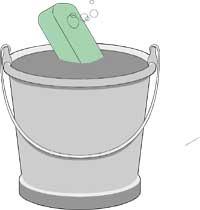Washing machine
Until a few years ago the washing machine was a luxury product and was in very few houses. In the baldeta, the laundry was put in hot water rubbing with the known soap tablets called lizards or sparks. Logically, by hand and individually, everything that had to be cleaned. For those of us who have always known the washing machine is a hard job to wash all the clothes by hand. However, for those who today are adults it was a great advance to have it at home.
This avoided having to go to laundries or river banks and streams to wash clothes. In the absence of water at home, in most of the villages of Euskal Herria the laundries were prepared and many women were picked up with a lot of clothes on their heads. In the laundries they had long smooth stones to wash clothes comfortably. Sometimes they also used a wooden board.
They put clothes on the stone or on the wood and, alternating with the soap pill and brush, rubbed the clothes. To speed up the hard work the women were dedicated to storytelling and even singing. They all seem old things, no doubt, but the recent history we have just made is that of Euskal Herria, that of here and we have not gone far back in time.
Towards a modern washing machine

If we make the leap into the Middle Ages, we discovered that they used a bucket to wash clothes. Since then it is certain that more than one inventor tried to find a system to facilitate the washing of clothes. The washing machine, a device similar to the one we know, was not the XIX. Until the 19th century. These first tools of the twentieth century would make us laugh at many. In a wooden container warm water and soap were mixed with clothes. These containers were the first mechanical cleaners. The ships had giant shovels to mix and move clothes, water and soap.
The principle used in the last century persists in modern washing machines: clothing is inserted into the cylinder and turns, shaking clothes from one side to the other. In short, the cylinder has the same function as the blades. Going back for years, in 1830 one of these mechanical washing machines was first operational in an English laundry; ten years later, in 1840, the industrial washing machine appeared in France. It was added a tube that expelled the water and the device operated with a crank.
The next big leap that came with the new century: In 1901 he invented the electric washing machine Alva J. American fisher. At the beginning of the century, therefore, the electric washing machine was invented, but the time of marketing was very high. In 1907, Hurley Machine Company patented Fisher's washing machine and when World War II was about to arrive, they settled on the US market to sell the first electric washing machines. Therefore, if we consider the year in which Fisher's invention was patented, this year the electric washing machine has turned ninety years.
The containers of those first appliances were vertical axis and the clothes of the container were shaken with shovels. No horizontal drum washers appeared until 1960.
Tour and tour
The current washing machine automatically cleans clothes by mechanical, thermal and chemical action. By mechanical action the drum rotates, while the thermal action controls the temperature of the water that will wash clothes and in detergents the chemical action.
The washing machine seen from outside is only a square of sheet metal. This sheet is enamelled or lacquered. If we start checking the washing machine inside, at first glance we will see the drum. Cylindrical and stainless steel container.

The position of the container also varies from washing machine to washing machine; the steel containers of some washing machines have the inlet and outlet hole of the clothes up and others forward. Although the entrance and exit of the clothes from the top of the washing machine is more comfortable, today most appliances have the side entrance, which forces the user to bend down. The mentioned stainless steel drum is cylindrical and full of holes. Clothing is inserted into this cylindrical container and the drum rotates around the horizontal or vertical axis. Through the holes enters and leaves the water slowly cleaning the clothes. The tube penetrates cold water inside and thanks to the armored resistances located at the bottom of the drum, the water is heated.
So far the cleaner was placed in the container that has the washing machine on the outside, but today many users incorporate soap on the drum along with clothes. In cases where the detergent is placed in the outer container, the drum automatically picks up the soap and with water begins to rotate the clothes on the drum. Once the clothes are cleaned, the detergent used in cleaning is removed. Detergents are removed by a tube.
Despite removing soap, we all know that another important step is needed for clothes to hang. The clothes are clean, but now we have to remove the biggest waters, because if not, we will get the lot of clothes dripping. The appliance itself will drain the clothes and is ready to remove it from the washing machine.
All this process is done by the washing machine automatically and allows to perform different programs Depending on the clothes, the user schedules the water temperature and the cleaning time. The draining should also be programmed and even if you want to remove the already dry clothes, the user should indicate this option. If you don't know how to give this last option to your home washing machine, don't worry, not all washing machines offer this possibility of drying clothes. However, attributing this error to the development of technology: the system is invented, lack of use...





